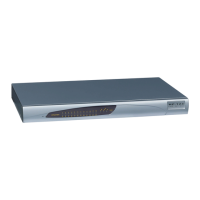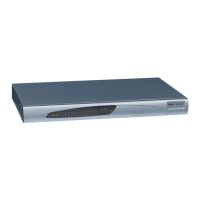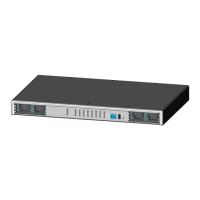Version 7.2 485 Mediant 1000B Gateway & E-SBC
User's Manual 23. Routing
(see ''Configuring Trunk Group Settings'' on page 467) or for all Trunk Groups, using the
global parameter ChannelSelectMode.
Configuration of IP-to-Tel routing rules includes two areas:
Match: Defines the characteristics of the incoming IP call (e.g., IP Group from which
the call is received).
Action: Defines the action that is done if the incoming call matches the characteristics
of the rule (i.e., routes the call to the specified Tel/Trunk Group destination).
The device searches the table from top to bottom for the first rule that matches the
characteristics of the incoming call. If it finds a matching rule, it sends the call to the Tel
destination configured for that rule. If it doesn't find a matching rule, it rejects the call.
If an IP-to-Tel call cannot be routed to the Trunk Group, the device can route it to an
alternative destination:
Routing to an Alternative Trunk Group: If the device sends the IP call to the Tel
destination and a subsequent call release reason (cause) code (e.g., 17 for User
Busy) is received from the Tel side, and you have configured this release reason code
in the Reasons for IP-to-Tel Alternative Routing table, the device re-routes the call to
an alternative Trunk Group if an alternative routing rule has been configured in the
table. The alternative routing rules must be configured in table rows (indices) that are
located anywhere below the "main" routing rule. For example, if you configure a "main"
routing rule in Index 4, the alternative routing rule can be configured in Index 6. In
addition, you must configure the alternative routing rules with identical matching
characteristics (e.g., destination prefix number) to the "main" routing rule, but assigned
with different destinations (i.e., Trunk Groups). For more information on IP-to-Tel
alternative routing and for configuring call release reasons for alternative routing, see
''Alternative Routing to Trunk upon Q.931 Call Release Cause Code'' on page
498.
Routing to an IP Destination (i.e., Call Redirection): The device can re-route the
IP-to-Tel call to an alternative IP destination, using SIP 3xx responses. For more
information, see ''Alternative Routing to IP Destinations upon Busy Trunk'' on page
500.
Routing to an Alternative Physical FXO Port or Trunk within Same Trunk Group: The
device can re-route an IP-to-Tel call to a different physical FXO port or trunk if the
destined FXO port or trunk within the same Trunk Group is out of service (e.g.,
physically disconnected). When the physical FXO port or trunk is disconnected, the
device sends the SNMP trap, GWAPP_TRAP_BUSYOUT_LINK notifying of the out-
of-service state for the specific FXO line or trunk number. When the FXO port or
physical trunk is physically reconnected, this trap is sent notifying of the back-to-
service state.

